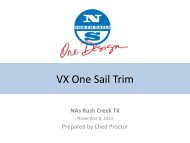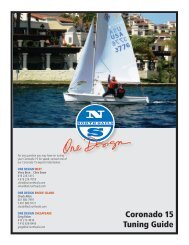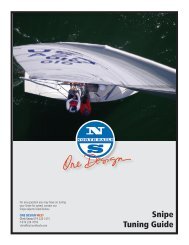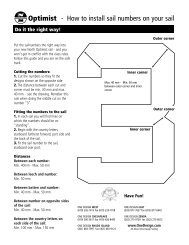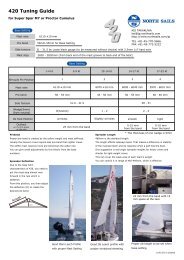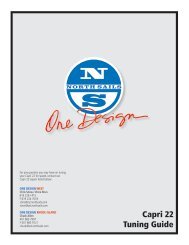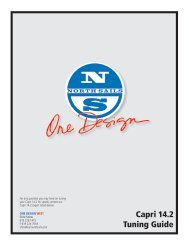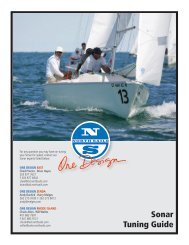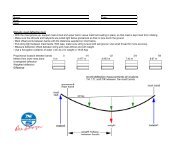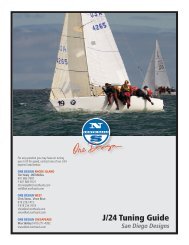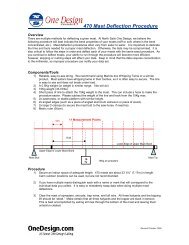Daysailer - North Sails - One Design
Daysailer - North Sails - One Design
Daysailer - North Sails - One Design
- No tags were found...
Create successful ePaper yourself
Turn your PDF publications into a flip-book with our unique Google optimized e-Paper software.
NORTH SAILSIn very heavy winds and with the helpof pulling on the boomvang, set themainsheet tension so that the upperbatten is again angled outboardapproximately 5 degrees from parallel tothe boom. It is important in winds above15 mph to apply some tension so thatthe mast will bend correctly to sufficientlyflatten out the sail for these conditions.The mainsail is very important in helpingsteer the Day Sailer upwind. Theskipper should always hold his mainsheetand be ready to ease it out quickly whenhe feels an increase in his weather helm(i.e. load on the helm acts as a brake.)When the boat is tracking well and thehelm is balanced, the skipper shouldslowly trim the mainsail back in.CUNNINGHAM AND JIB CLOTHTENSIONPull the Cunningham on your main andthe jib cloth tension just tight enoughto barely remove horizontal wrinkles. Itis best to leave just a hint of horizontalwrinkles on the mainsail and slight “crow’sfeet” off the snaps of your jib so that youknow the luff tension on both sails is nottoo tight.Day SailerTuning GuideD SOUTHAULPull the outhaul so that the bolt rope onthe foot is just standing up straight in allconditions except in very heavy windswhen overpowered. In these conditionspull the outhaul nearly to the band. .Ease the outhaul 2” to 3” when sailingdownwind.BOOMVANGDownwind trim the vang hard enough tokeep the boom and the leech supportedon the mainsail. Use the guide of settingthe upper batten parallel to the boom.When the boomvang is trimmed correctly,the telltale should fly straight off the leechat the upper batten. We feel that in theDay Sailer class there is a tendency for theboomvang to be pulled too hard whensailing downwind. This will over tightenthe leech up top and due to the side bendof the mast, over flatten the mainsail.As mentioned earlier, upwind in heavy airthe boomvang is set hard enough to resistupward movement of the boom to adjustthe upper batten to ease no more than 5to 10 degrees past parallel to the boom.The mainsheet, in these conditions simplyacts as a traveler and allows the boom tomove mostly sideways and outbound.Visit our web site at www.<strong>One</strong><strong>Design</strong>.com for the latest Day Sailer news and tuning tips.© 2007 <strong>North</strong> <strong>Sails</strong> <strong>One</strong> <strong>Design</strong>. All rights reserved.3
NORTH SAILSJIB TRIMDay SailerTuning Guideyou should make the top of the jib break slightly ahead of the bottom.D STrim the jib sheet so that upper leechof the jib is angled outboard aboutapproximately 10 degrees in mostconditions. In very flat water and mediumwinds you may be able to trim the sheetslightly tighter. In light lumpy conditionstrim the sheet looser so the middle of theleech is slightly open as well.JIB LEADSet your jib fore and aft so that the telltalesbreak nearly even from top to thebottom on the jib as you luff the boatslowly into the wind. If the upper telltalebreaks first, move the jib lead slightly aft.If you were to err one way or the other,A good starting point is set the lead jib block 9’3 ½” aft from the jib luff wire measuredaround the cutty.In heavy winds, it is helpful to move the lead aft 2” to 3” so that the top of the jib doesbreak early flattening out the upper section of the jib and therefore helping to de-powerthe boat.Most Day Sailer skippers have fitted their boats with inhaul lines to help pull the jibleads inboard for proper upwind performance. These lines, added to the top of the cutty,will pull the jib sheet inboard to a point where the sheet if extended would cross thecutty 16” from the centerline. This is not the sheave position on the block, but where thesheet would strike the fiberglass if extended on.In breezy conditions we suggest moving your leads outboard (and aft) 1-1 ½”. If verylight, and especially choppy conditions move your lead outboard 2” to 18” off centerline.Be sure to ease the sheet in these conditions.Visit our web site at www.<strong>One</strong><strong>Design</strong>.com for the latest Day Sailer news and tuning tips.© 2007 <strong>North</strong> <strong>Sails</strong> <strong>One</strong> <strong>Design</strong>. All rights reserved.4
NORTH SAILSDay SailerTuning GuideD SDave Keran, Day Sailer National Champion, describes his method and set-up of using his inhaulers below.Thanks Dave!!“The barberhaulers exit from through-deck bullseyes on the vertical face on the aft end of the cuddy. The exits are about 8” fromcenterline and lines cross to the other side of the boat from where they exit. We sail with the barberhauler block positioning thejibsheet 12” off centerline which means the block is 20” from the bullseye. I believe that the position of the bullseye (both fore and aftand laterally) and the length of the barberhauler line are important in getting the right trim on the jib. If the lines exit forward, on thetop of the cuddy, they cause the jib to cup into the main when closehauled and the shape becomes less than optimal. Secondly if jib ispulled down to the cuddy either by a short line or to a track with a block I think the leach gets too tight. By allowing the barberhaulerblock to float I feel the jib is properly tensioned on the leach and the foot.”SPINNAKER TRIMSail your Day Sailer spinnaker with a 6” to 12” curl in the luff. Careful concentration is necessary. Use short 2” eases and trims onthe sheet to keep the spinnaker trimmed correctly. Keep the clews even at all times through adjustments to your topping lift. In someconditions, it is sometimes difficult to see the leeward clew behind the mainsail so you can use another guide where you adjust yourpole height to keep center vertical seem parallel to the mast.We wish you good luck and fast sailing! Don’t hesitate to give us a call if you have any questions or problems.Contact <strong>North</strong> <strong>Sails</strong>For tuning information and complete details on how to setup your sails contact the <strong>North</strong> Day Sailer experts listed on the cover of thisguide.Visit our web site at www.<strong>One</strong><strong>Design</strong>.com for the latest Day Sailer news and tuning tips.© 2007 <strong>North</strong> <strong>Sails</strong> <strong>One</strong> <strong>Design</strong>. All rights reserved.5
NORTH SAILSNORTH SAILS ONE DESIGNQUALITY CONTROL CHECKDay SailerDay SailerTuning GuideD SMAINSAIL JIB SPINNAKERCorners Corners CornersCunningham Telltales Numbers (one side)Numbers Leech telltales Royalty (signed)Battens Wire <strong>North</strong> LogoLeech Telltales Luff tabs BagClew slug<strong>North</strong> LogoChafe PatchBagInsignia<strong>North</strong> LogoBagChecked by: _____________________Date: ____ / ____ / ____Visit our web site at www.<strong>One</strong><strong>Design</strong>.com for the latest Day Sailer news and tuning tips.© 2007 <strong>North</strong> <strong>Sails</strong> <strong>One</strong> <strong>Design</strong>. All rights reserved.6



